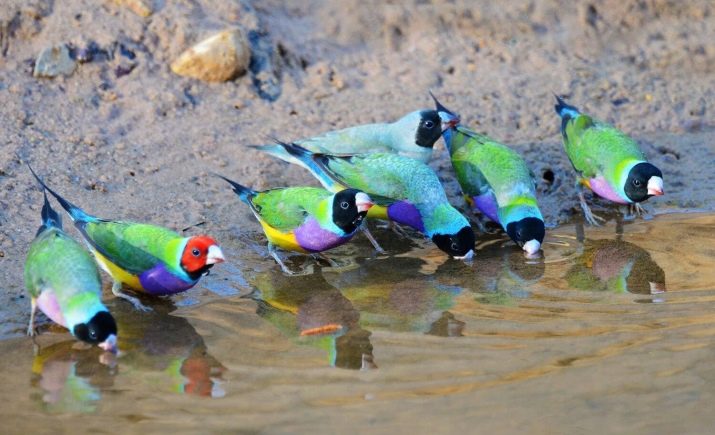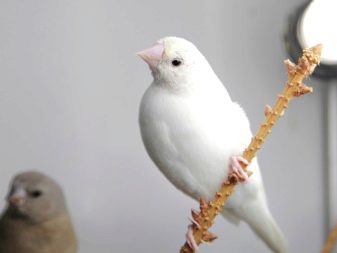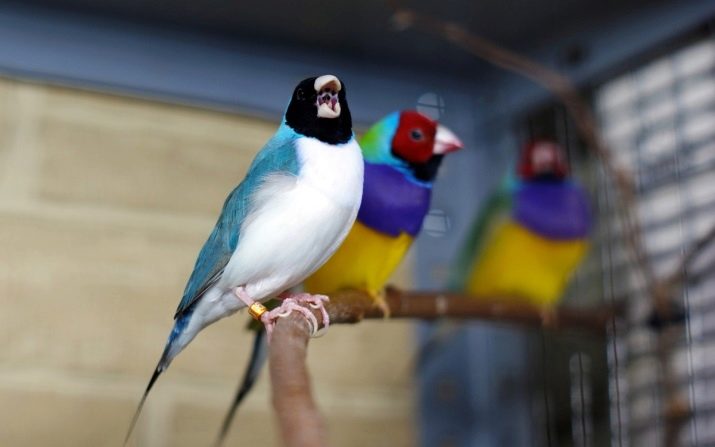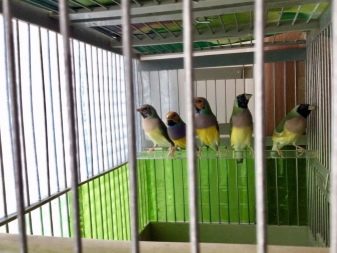Among the variety of birds found in the world, special attention deserves representatives with variegated coloring and the ability to bewitching singing. The varieties of such birds include Amadin Gould, which, in the light of their decorative attractiveness, is kept at home.

Description
According to recent characteristics that were given to these birds, in addition to wildlife, they were able to exist only in greenhouse or terrarium conditions in captivity, which significantly narrowed the circle of their demand. However, over time, Amadin Gould still managed to adapt to the environment, allowing the cultivation of attractive birds in ordinary home conditions. Today, among poultry farmers there are a number of unofficial names of this breed - guilds, guilders, guilds and other derivatives of the official. Amadina Gould owes its universally recognized name to the discoverer of these birds, traveler and explorer John Gould.
In their natural environment, Amadins inhabit mostly the north of Australia. In this part of the mainland, flocks of Amadins migrate along the coastline with a certain frequency, being guided by the weather conditions of the continent, from which the peculiarities of the availability of this or that food, as well as the accepted breeding dates, follow.

In the natural environment, Amadina Gould is small bird with colorful and bright feathers. However, despite their miniature size, they are able to endure various extreme conditions that relate to the specifics of their habitats.
In the wild, birds live at air temperatures ranging from +35 C to +45 C, while the average humidity is 80%.
Like other species of Amadinae, they belong to flocking species that migrate together in large numbers. Ornithologists distinguish 3 main types of Gould’s amadines, which can be found in the wild and hot nature:
- blackheads;
- orange-headed;
- red-headed.

In some cases, there are female representatives who have an intermediate color of the head. Differences in the color of representatives of one species may vary depending on gender. Therefore, as with most birds, Amadine females have a faded feather color, but in the same color scheme, which helps to distinguish one individual from another.
Breeders also bred hybrid forms of this breed, which have distinctive characteristics not only in the color of feathers on the head, but can also be distinguished by differences in the color of the thoracic region. Today, if desired, it will be possible to purchase pink-breasted birds, individuals with a white or pastel color.


Regardless of color, all representatives of the breed perfectly interbreed.
It is worth noting the distinctive characteristics of Amadin Gould.
- Birds are notable for strong and well-developed immunity. This makes it possible for breeders to provide beautiful birds with long life spans when providing proper conditions for keeping them.
- Among the features of amadins it is worth noting the unique trills that males are capable of.
- The main advantage of the species is the colorful color that persists in birds throughout life.
- In general, Amadins show a positive attitude when kept together even with birds of other species. Between themselves, individuals also maintain friendly relations.
- With proper breeding, representatives of the species acquire excellent stress resistance.
- A preliminary study of all the intricacies of bird care will allow you to have multi-colored singing birds at home, making a minimum of effort to keep them.

However, this species also has other distinctive features that can be attributed to the minuses of the breed:
- high price;
- deficiency of birds;
- the need to maintain high humidity in the cell;
- breeding amadins has its own nuances that require direct participation from the breeder;
- birds have a predisposition to some rare diseases.

Growing conditions
Guldova Amadina does not differ from her close relatives by preferences in terms of placement, therefore spacious cells will be a suitable option for keeping.


This is due to the need for activity and communication with other members of the pack.
In addition, birds of this species are prone to overeating and gaining excess weight, so the space for movement for amadins will be vital.
The optimal cell size for two individuals will be the design parameters with a length of not less than 80 centimeters, while the height should be more than 50 centimeters. Such a dwelling will allow birds to take off, briefly lingering in the air. To maintain the guild amadine, it will also be necessary to place several rails inside at a height, but in such a way that they do not become obstacles in flight. Removal of poles from the walls of the cell should be 2-4 centimeters, and their thickness should not be too large so as not to provoke the curvature of the paws.

As neighbors in the joint keeping of birds of different species, preference should be given Japanese Amadins, which can contribute to the reproduction of guilds.

However, flock maintenance will require the use of an aviary, not a cage, so that all inhabitants can move freely, which will also reduce the possibility of conflicts.
Amadins are very fond of water, so in addition to perches and feeders in the cage or aviary should be present swimmers, which are usually attached internally to the wall.

Water should be freely available around the clock so that birds use it when necessary.
Such an obligatory attribute will require regular replacement of the liquid, the Amadin breeder needs to ensure that there are no residues of feed, feathers or waste products in it, since unsanitary conditions can lead to the development of various diseases.
Among the often used additional devices that can be useful to birds in a cage or aviary, it is worth noting swing, but not all representatives of this species use them, everything will depend on the nature of the feathered individual.


Bird care
In light of the fact that even in captivity, Amadins live several pairs in one cage, the breeder will need to constantly monitor their condition and cleanliness of the home. Leaving involves filling bathes and purifying them from pollution. Also, clean water should be in drinking bowls.

The frequency of cell harvesting is an issue that is decided individually in each case. Everything will depend on the number of birds and their behavior. However, to avoid unpleasant situations, the pallet in the cage should be cleaned every day. As for the planned washing of the entire enclosure, such work can be carried out once a week. The essence of the general cleaning will be reduced to washing the poles, swings, rods of the cage itself. At this time, the birds should be temporarily planted. It is not recommended to use any special means for washing, it is most correct to carry out the treatment with a soapy solution, after which, pour over all the elements with boiling water and wipe dry.

Proper feeding
The basis in the diet of birds will be a special grain mixture, consisting mainly of unpeeled millet.

As a rule, amadine nutrition does not undergo drastic changes throughout life. In the wild, guilds eat insects, they feed their younger generation, but at home, not every individual will prefer such a variety in the diet, but you can accustom to the "live" feeding of birds. In addition, the presence of such a component in the menu will have a beneficial effect on the health of Amadins, but there is no urgent need for this.
The owner of such birds should also be included in their menu. greens. It can be dandelion leaves, woodwort.


Birds will respond positively to goodies in the form of fruits. It can be apples and other quite affordable seasonal options.
Also, guild breeders will need to accustom them to use sprouted grain which contains almost all the necessary vitamins and minerals.


Such top dressing will become especially relevant during the breeding season of birds.
Before purchasing amadins, breeders should know that small birds have an accelerated metabolism, so even short hunger strikes are extremely contraindicated for them. Even a day without food for a bird can be disastrous.
Ready-made grain mixtures do not always contain gravel, which is vital for these birds. In the wild, birds procure it on their own, swallowing small grains of sand or stones. It is this component that will become important for the full digestion of food, as well as for the natural emptying of the intestine. Therefore, the owner of the guilds will have to purchase it additionally.


Gravel can be given to birds in different ways. Some owners of beautiful birds use a separate feeding trough for feeding, you can also pour a small amount of gravel to the bottom of the cage, add it to the grain. The choice of introducing gravel into the diet will depend on the personal preferences of the breeder.
Another important point in ensuring the proper diet will be availability of a drinking bowl in free access with clean water. Depending on the size of the cage and the number of birds, there may be several.
Breeding
There is an opinion that the Amadins of Gould are bad parents. However, this is not quite true. The attitude of birds to their chicks is due to the specifics of growing offspring in the wild, where guild breeding occurs during the rainy season, when there is no food shortage - plants develop fairly quickly, seeds are pollinated, insects are also abundant. And when the chicks have already hatched, air temperature and humidity are at their peak, which allows parents to leave their nests for a long time, without fear that the growing guilds will freeze.

However, in the conditions of the city, when keeping amadins at home, it will be extremely difficult to create similar conditions for them, therefore, breeders will need to make every effort to obtain offspring. It is possible to maintain heat for the chicks by lighting devices or to allow the offspring of guilds to grow other birds, provided that they exist.

In order for the Amadins to begin to nest in the cage, they will need to make a nesting house with good bedding for their masonry, which is usually used as a feather and rags. The dimensions of the nest will be small, since the masonry and birds themselves are not distinguished by large dimensions and weight. The optimal age for mating for the female will be 1 year, it is during this period that birds should be combined to obtain offspring, placed in the cage material for the construction of the nest.

You will learn more about Amadins by watching the following video.









